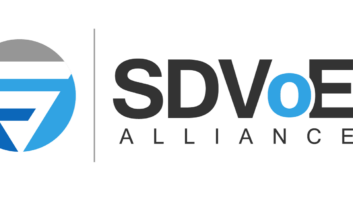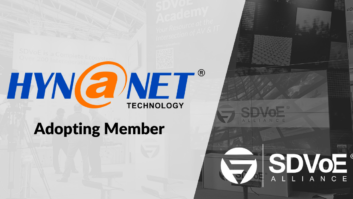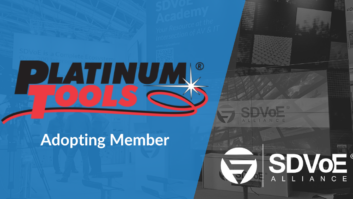
The SDVoE Alliance seeks to drive the adoption of AV over IP with HDBaseT-like levels of performance. Paddy Baker spoke to Alliance president Justin Kennington, director of strategic and technical marketing at chipset manufacturer AptoVision, about the Alliance’s philosophies, technologies and targets.
What’s the thinking behind the SDVoE Alliance?
The fundamental idea here is that we are trying to move the industry conversation beyond the idea of the most important question being ‘what is the transport?’ What we want to do almost is to take the transport for granted. We’ve gotten to a place, certainly reflected last ISE and InfoComm, where everyone seems very interested in moving AV over IP, and very many manufacturers have solutions to do that.
I think we’ve reached a point of confusion in the industry: everyone seems to agree that video over IP is a good idea and it’s what we should do, but with all these different approaches, no-one’s very sure how this is going to work.
So what’s your approach?
What we’re trying to do with SDVoE – software-defined video over Ethernet – is first and foremost to establish a baseline transport of video over IP, to define some baseline performance characteristics that we require – meaning HDBaseT-level performance characteristics: zero latency, zero compression – because those are requirements needed in pro AV that are a challenge to achieve over Ethernet but can be done now.
But more than to define that transport, we want to acknowledge that once we’ve moved away from older-style matrix switches –where the functionality and even the logical partitioning of the video network is defined exclusively by its physical architecture – we can create a technology that can move content over Ethernet, process and shape it, and provide a very clean, easy-to-use software API for managing the transport, the switching and the processing.
And the idea, which I think is reflected in many other communications technologies well outside of pro AV, is once we’ve created that platform of hardware and a software-layer interface, now the industry of manufacturers and software developers can really exercise their creativity. They can spend less time and effort thinking about the very excruciating details of how to build hardware, how to design a matrix switch, and instead focus on how to use software to create good user experiences.
In the old matrix ecosystem, the value from a manufacturer is concentrated in the matrix switch; it’s very complex to design the firmware and basic controller software that makes a matrix switch tick. Meanwhile the endpoints – HDBT transmitters, receivers and extenders – are basically commodity devices: you can buy extenders for $200.
If you look at the new ecosystem as we see it through the lens of SDVoE, we’ve taken all the value out of switching and put that into commodity off-the-shelf Ethernet gear that we can buy from any number of manufacturers. That’s because all we really need in terms of transport is just dumb heavy lifting – moving a load of bits from point A to point B – and frankly it’s the kind of heavy lifting that the IT industry is so much better to address than the AV industry is. And that’s reflected in the prices of equipment: you can buy a 48-port 10-gig Ethernet switch for $5,000 at retail; a 48-port HDBaseT matrix switch is a $30,000-40,000 item, and it doesn’t have the same kinds of flexibility as the Ethernet switch, or the advantages of size and power consumption; or the low and falling cost.
There’s no value that an AV manufacturer can add when it comes to the raw switching and moving of bits. Where we can add value as an industry is any time we touch the real AV signal. In the SDVoE ecosystem, the value has been pushed out to the edges of the network, to what we call processing nodes. These are encoders and decoders that modify video signals by scaling and making videowalls; or modify audio signals by cross-routing them by downmixing them or any other sort of processing.
Once we’ve created those high-value processing nodes plugged into this commodity network, we need something to control it. That’s where our API comes in. It provides an interface to the other key value the manufacturers will bring in the future, which is the software that creates the user experience. So the API becomes the interface between where the value is: the processing nodes and the user-facing software.
What does this mean for the market?
I think the overall result of this will be to significantly lower the barrier to entry for new players. Today it’s incredibly expensive to decide you want to become a new matrix switch manufacturer – you’ll need tens of million dollars in R&D investment in dozens and dozens of products before you can start to compete with entrenched established players.
And because that barrier is very much lower, we’ll see AV as an industry being able to extend its reach further into more niche applications that we couldn’t afford to go into from an R&D perspective before. I think we’ll see entirely new classes of AV application, and frankly I don’t even know what those are. When iOS and Android were created as software platforms built on some hardware, they didn’t know it would create airbnb and Uber; developers spotted market opportunities and started building the applications that users could enjoy. And that’s what I expect to happen here.
Can you say some more about the confusion that exists today in this area, and how the Alliance and its baseline performance characteristics will help to solve it?
Across the board everyone wants to have an AV over IP story, but everyone’s story is a little bit different: some think it should be H.264 for low bandwidth but compromised latency, some think AVB/TSN is the right solution despite its requirement for specialised network switches.
Any time that you’re looking at a video over IP solution you’re going to have to make some engineering trade-offs between video quality, bandwidth consumption and latency. Even if you go outside of video over IP and look at HDBaseT, the compromise they’ve chosen, which is a useful one, is perfect video quality, zero latency, but what I call infinite bandwidth: it can’t run across your network, it’s a dedicated cable that carries one stream of video.
I think that pro AV will continue to demand that kind of performance in terms of video quality and latency – and in terms of all the sphere of video over IP technologies that are out there, SDVoE is the only one that can truly offer zero compression, perfect image quality and zero latency. So that’s why we wanted to build an alliance around it.
AptoVision’s offering, which of course has ties to SDVoE technology, is a chipset available to any manufacturer, so that they can create a video over IP solution that reaches the high performance requirements of pro AV.
Tell me more about the API.
SDVoE also offers the kind of processing capabilities that are so often needed in pro AV. These days a system that’s completely successful in all environments needs digital video upscalers and downscalers, with frame rate converters; our processing technology includes composting and multiview, it includes videowall capabilities. More and more, integrators think of their AV systems as a collection of sources outputting content in different formats, to a collection of displays of different shapes, sizes and pixel counts. We want to offer them the processing capability to match up those sources to those displays with an easy interface.
Getting the content from point A to point B is absolutely necessary, but it’s so much less than the total of everything we have to do today. The idea of the SDVoE programmable API is to make it very easy to control these powerful processing engines and create user experiences without months or even years of custom development for every task.






